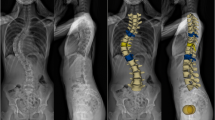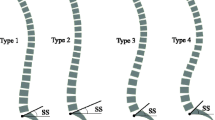Abstract
Purpose
To examine whether the sacro-femoral-pubic (SFP) angle could estimate pelvic tilt (PT) in scoliotic and normal subjects.
Methods
One hundred nine subjects including 38 patients with adolescent idiopathic scoliosis (AIS), 35 patients with congenital scoliosis (CS), and 36 healthy individuals were studied. PT, as the angle between the lines connecting the midpoint of the sacral plate to the centroid of one acetabulum and the vertical plane, and the SFP angle, as the angle between the midpoint of the upper sacral endplate, the centroid of one acetabulum, and the upper midpoint of the pubic symphysis, were calculated on full-length lateral and anteroposterior radiographs, respectively. Correlations between PT and the SFP angle were investigated in each group.
Results
The three groups were comparable in terms of age, sex, and the mean SFP angle. The mean PT, however, was significantly lower in healthy subjects compared to that in patients with AIS and CS. Significant and reverse correlations were present between PT and the SFP angle in all three groups (AIS: r = −0.32, p = 0.04, PT = 82.5 − average SFP angle; CS: r = −0.48, p = 0.003, PT = 95.41 − average SFP angle; healthy: r = −0.33, p = 0.04, PT = 88.95 − average SFP angle).
Conclusions
Unlike two previous reports, the SFP angle correlated poorly to PT in this study, limiting its use as a suitable surrogate for PT in scoliotic and healthy subjects.



Similar content being viewed by others
References
Schwab F, Lafage V, Patel A, Farcy JP (2009) Sagittal plane considerations and the pelvis in the adult patient. Spine 34(17):1828–1833. doi:10.1097/BRS.0b013e3181a13c08
Gangnet N, Dumas R, Pomero V, Mitulescu A, Skalli W, Vital JM (2006) Three-dimensional spinal and pelvic alignment in an asymptomatic population. Spine 31(15):E507–E512. doi:10.1097/01.brs.0000224533.19359.89
Vialle R, Levassor N, Rillardon L, Templier A, Skalli W, Guigui P (2005) Radiographic analysis of the sagittal alignment and balance of the spine in asymptomatic subjects. J bone Jt Surg Am 87(2):260–267. doi:10.2106/JBJS.D.02043
El Fegoun AB, Schwab F, Gamez L, Champain N, Skalli W, Farcy JP (2005) Center of gravity and radiographic posture analysis: a preliminary review of adult volunteers and adult patients affected by scoliosis. Spine 30(13):1535–1540
Schwab F, Lafage V, Farcy JP, Bridwell K, Glassman S, Ondra S, Lowe T, Shainline M (2007) Surgical rates and operative outcome analysis in thoracolumbar and lumbar major adult scoliosis: application of the new adult deformity classification. Spine 32(24):2723–2730. doi:10.1097/BRS.0b013e31815a58f2
Schwab FJ, Lafage V, Farcy JP, Bridwell KH, Glassman S, Shainline MR (2008) Predicting outcome and complications in the surgical treatment of adult scoliosis. Spine 33(20):2243–2247. doi:10.1097/BRS.0b013e31817d1d4e
Vrtovec T, Janssen MM, Likar B, Castelein RM, Viergever MA, Pernus F (2012) A review of methods for evaluating the quantitative parameters of sagittal pelvic alignment. Spine J Off J N Am Spine Soc 12(5):433–446. doi:10.1016/j.spinee.2012.02.013
Guo J, Liu Z, Lv F, Zhu Z, Qian B, Zhang X, Lin X, Sun X, Qiu Y (2012) Pelvic tilt and trunk inclination: new predictive factors in curve progression during the Milwaukee bracing for adolescent idiopathic scoliosis. Eur Spine J Off Publ Eur Spine Soc Eur Spinal Deform Soc Eur Sect Cerv Spine Res Soc 21(10):2050–2058. doi:10.1007/s00586-012-2409-6
Lafage V, Schwab F, Patel A, Hawkinson N, Farcy JP (2009) Pelvic tilt and truncal inclination: two key radiographic parameters in the setting of adults with spinal deformity. Spine 34(17):E599–E606. doi:10.1097/BRS.0b013e3181aad219
Tyrakowski M, Yu H, Siemionow K (2014) Pelvic incidence and pelvic tilt measurements using femoral heads or acetabular domes to identify centers of the hips: comparison of two methods. Eur Spine J Off Publ Eur Spine Soc Eur Spinal Deform Soc Eur Sect Cerv Spine Res Soc. doi:10.1007/s00586-014-3739-3
Ji X, Chen H, Zhang Y, Zhang L, Zhang W, Berven S, Tang P (2015) Three-column osteotomy surgery versus standard surgical management for the correction of adult spinal deformity: a cohort study. J Orthop Surg Res 10(1):23. doi:10.1186/s13018-015-0154-3
Baek SW, Kim C, Chang H (2015) The relationship between the spinopelvic balance and the incidence of adjacent vertebral fractures following percutaneous vertebroplasty. Osteoporos Int. doi:10.1007/s00198-014-3021-x
Blondel B, Schwab F, Patel A, Demakakos J, Moal B, Farcy JP, Lafage V (2012) Sacro-femoral-pubic angle: a coronal parameter to estimate pelvic tilt. Eur Spine J Off Publ Eur Spine Soc Eur Spinal Deform Soc Eur Sect Cerv Spine Res Soc 21(4):719–724. doi:10.1007/s00586-011-2061-6
Duval-Beaupere G, Schmidt C, Cosson P (1992) A Barycentremetric study of the sagittal shape of spine and pelvis: the conditions required for an economic standing position. Ann Biomed Eng 20(4):451–462
Legaye J, Duval-Beaupere G, Hecquet J, Marty C (1998) Pelvic incidence: a fundamental pelvic parameter for three-dimensional regulation of spinal sagittal curves. Eur Spine J Off Publ Eur Spine Soc Eur Spinal Deform Soc Eur Sect Cerv Spine Res Soc 7(2):99–103
Lafage V, Schwab F, Skalli W, Hawkinson N, Gagey PM, Ondra S, Farcy JP (2008) Standing balance and sagittal plane spinal deformity: analysis of spinopelvic and gravity line parameters. Spine 33(14):1572–1578. doi:10.1097/BRS.0b013e31817886a2
Imai N, Ito T, Suda K, Miyasaka D, Endo N (2013) Pelvic flexion measurement from lateral projection radiographs is clinically reliable. Clin Orthop Relat Res 471(4):1271–1276. doi:10.1007/s11999-012-2700-1
Bao H, Liu Z, Zhu F, Zhu Z, Wang F, Bentley M, Qian B, Qiu Y (2014) Is the sacro-femoral-pubic angle predictive for pelvic tilt in adolescent idiopathic scoliosis patients? J Spinal Disord Tech 27(5):E176–E180. doi:10.1097/BSD.0000000000000086
Feiz HH, Afrasiabi A, Parvizi R, Safarpour A, Fouladi RF (2012) Scoliosis after thoracotomy/sternotomy in children with congenital heart disease. Indian J Orthop 46(1):77–80. doi:10.4103/0019-5413.91639
Herring JA, Tachdjian MO, Texas Scottish Rite Hospital for Children (2008) Tachdjian’s pediatric orthopaedics, 4th edn. Saunders/Elsevier, Philadelphia
Hyun SJ, Rhim SC (2010) Clinical outcomes and complications after pedicle subtraction osteotomy for fixed sagittal imbalance patients: a long-term follow-up data. J Korean Neurosurg Soc 47(2):95–101. doi:10.3340/jkns.2010.47.2.95
Rose PS, Bridwell KH, Lenke LG, Cronen GA, Mulconrey DS, Buchowski JM, Kim YJ (2009) Role of pelvic incidence, thoracic kyphosis, and patient factors on sagittal plane correction following pedicle subtraction osteotomy. Spine 34(8):785–791. doi:10.1097/BRS.0b013e31819d0c86
Jiang J, Qiu Y, Mao S, Zhao Q, Qian B, Zhu F (2010) The influence of elastic orthotic belt on sagittal profile in adolescent idiopathic thoracic scoliosis: a comparative radiographic study with Milwaukee brace. BMC Musculoskelet Disord 11:219. doi:10.1186/1471-2474-11-219
Lazennec JY, Brusson A, Rousseau MA (2011) Hip-spine relations and sagittal balance clinical consequences. Eur Spine J Off Publ Eur Spine Soc Eur Spinal Deform Soc Eur Sect Cerv Spine Res Soc 20(Suppl 5):686–698. doi:10.1007/s00586-011-1937-9
Mac-Thiong JM, Labelle H, Roussouly P (2011) Pediatric sagittal alignment. Eur Spine J Off Publ Eur Spine Soc Eur Spinal Deform Soc Eur Sect Cerv Spine Res Soc 20(Suppl 5):586–590. doi:10.1007/s00586-011-1925-0
Le Huec JC, Saddiki R, Franke J, Rigal J, Aunoble S (2011) Equilibrium of the human body and the gravity line: the basics. Eur Spine J Off Publ Eur Spine Soc Eur Spinal Deform Soc Eur Sect Cerv Spine Res Soc 20(Suppl 5):558–563. doi:10.1007/s00586-011-1939-7
Mac-Thiong JM, Berthonnaud E, Dimar JR 2nd, Betz RR, Labelle H (2004) Sagittal alignment of the spine and pelvis during growth. Spine 29(15):1642–1647
Yong Q, Zhen L, Zezhang Z, Bangping Q, Feng Z, Tao W, Jun J, Xu S, Xusheng Q, Weiwei M, Weijun W (2012) Comparison of sagittal spinopelvic alignment in Chinese adolescents with and without idiopathic thoracic scoliosis. Spine 37(12):E714–E720. doi:10.1097/BRS.0b013e3182444402
Zarate-Kalfopulos B, Romero-Vargas S, Otero-Camara E, Correa VC, Reyes-Sanchez A (2012) Differences in pelvic parameters among Mexican, Caucasian, and Asian populations. J Neurosurg Spine 16(5):516–519. doi:10.3171/2012.2.SPINE11755
Lonner BS, Auerbach JD, Sponseller P, Rajadhyaksha AD, Newton PO (2010) Variations in pelvic and other sagittal spinal parameters as a function of race in adolescent idiopathic scoliosis. Spine 35(10):E374–E377. doi:10.1097/BRS.0b013e3181bb4f96
Mac-Thiong JM, Roussouly P, Berthonnaud E, Guigui P (2011) Age- and sex-related variations in sagittal sacropelvic morphology and balance in asymptomatic adults. Eur Spine J Off Publ Eur Spine Soc Eur Spinal Deform Soc Eur Sect Cerv Spine Res Soc 20(Suppl 5):572–577. doi:10.1007/s00586-011-1923-2
Mac-Thiong JM, Labelle H, Berthonnaud E, Betz RR, Roussouly P (2007) Sagittal spinopelvic balance in normal children and adolescents. Eur Spine J Off Publ Eur Spine Soc Eur Spinal Deform Soc Eur Sect Cerv Spine Res Soc 16(2):227–234. doi:10.1007/s00586-005-0013-8
Upasani VV, Tis J, Bastrom T, Pawelek J, Marks M, Lonner B, Crawford A, Newton PO (2007) Analysis of sagittal alignment in thoracic and thoracolumbar curves in adolescent idiopathic scoliosis: how do these two curve types differ? Spine 32(12):1355–1359. doi:10.1097/BRS.0b013e318059321d
Panjabi MM, Oxland TR, Yamamoto I, Crisco JJ (1994) Mechanical behavior of the human lumbar and lumbosacral spine as shown by three-dimensional load-displacement curves. J Bone Jt Surg Am 76(3):413–424
Danielson ME, Beck TJ, Lian Y, Karlamangla AS, Greendale GA, Ruppert K, Lo J, Greenspan S, Vuga M, Cauley JA (2013) Ethnic variability in bone geometry as assessed by hip structure analysis: findings from the hip strength across the menopausal transition study. J Bone Miner Research Off J Am Soc Bone Miner Res 28(4):771–779. doi:10.1002/jbmr.1781
Solomon LB, Howie DW, Henneberg M (2014) The variability of the volume of os coxae and linear pelvic morphometry. Considerations for total hip arthroplasty. J Arthroplast 29(4):769–776. doi:10.1016/j.arth.2013.08.015
Straus WL (1927) The human ilium: Sex and stock. Am J Phys Anthropol 11(1):1–28. doi:10.1002/ajpa.1330110102
Giampietro PF, Blank RD, Raggio CL, Merchant S, Jacobsen FS, Faciszewski T, Shukla SK, Greenlee AR, Reynolds C, Schowalter DB (2003) Congenital and idiopathic scoliosis: clinical and genetic aspects. Clin Med Res 1(2):125–136
Badii M, Shin S, Torreggiani WC, Jankovic B, Gustafson P, Munk PL, Esdaile JM (2003) Pelvic bone asymmetry in 323 study participants receiving abdominal CT scans. Spine 28(12):1335–1339. doi:10.1097/01.BRS.0000065480.44620.C5
Berry JL, Stahurski T, Asher MA (2001) Morphometry of the supra sciatic notch intrailiac implant anchor passage. Spine 26(7):E143–E148
Conflict of interest
None.
Author information
Authors and Affiliations
Corresponding author
Rights and permissions
About this article
Cite this article
Ghandhari, H., Fouladi, D.F., Safari, M.B. et al. Correlation between pelvic tilt and the sacro-femoral-pubic angle in patients with adolescent idiopathic scoliosis, patients with congenital scoliosis, and healthy individuals. Eur Spine J 25, 394–400 (2016). https://doi.org/10.1007/s00586-015-3952-8
Received:
Revised:
Accepted:
Published:
Issue Date:
DOI: https://doi.org/10.1007/s00586-015-3952-8




